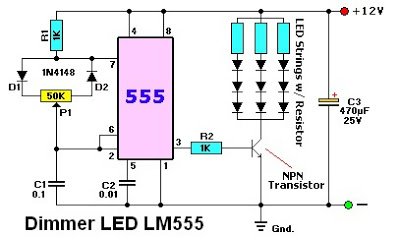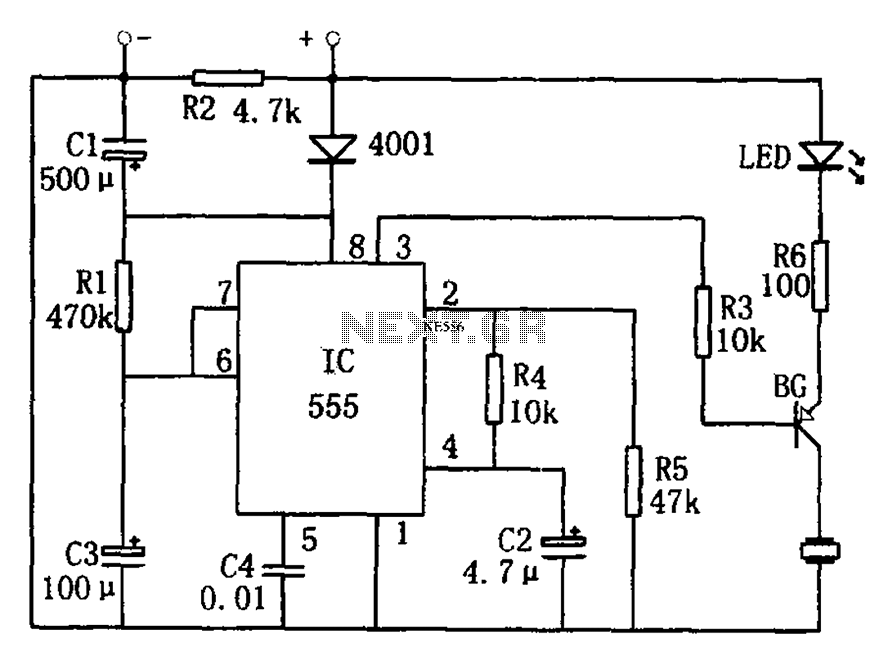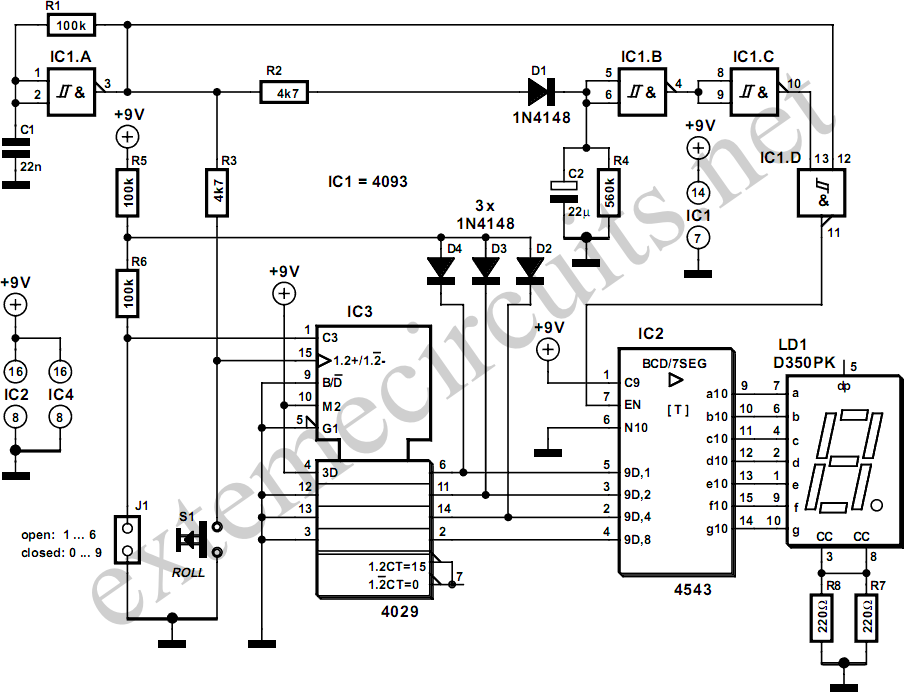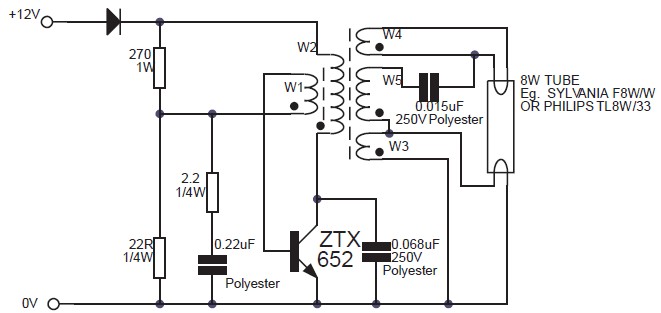
Electronic Circuit Schematic Dimmer LED using LM555 for Photo/Build Light

The LM555 timer IC can be utilized in various electronic projects, including the creation of an analog timer. According to the datasheet, the LM555 is versatile and can be adjusted to set timers based on specific requirements. The schematic indicates that a 50K potentiometer (P1) connected to a capacitor (C1) can be used to modify the delay time for dimming an LED. The output from pin number 3 serves as a clock signal, which acts as an input for an NPN transistor. This NPN transistor functions as a switch, controlled by the output signal from pin 3 of the LM555. Various NPN transistors, such as D400 or TIP31, can be employed based on the power requirements needed to turn on and off LED strings. With higher power, it is possible to arrange more than nine LED strings.
The LM555 timer is a highly adaptable integrated circuit that can operate in astable, monostable, and bistable modes. In this application, it is configured in monostable mode to create a delay timer for dimming LEDs. The timing interval is determined by the values of the resistor (P1) and capacitor (C1), where the time period (T) can be calculated using the formula T = 1.1 * R * C. The selection of a 50K potentiometer allows for variable resistance, enabling fine-tuning of the delay time.
The output from pin 3 of the LM555 provides a square wave signal that can effectively drive an NPN transistor. The transistor acts as a switch that can control larger loads, such as multiple LED strings, without being directly powered by the LM555. When the output from pin 3 goes high, it allows current to flow through the base of the NPN transistor, thereby turning it on and allowing current to pass through the collector-emitter path, illuminating the LEDs.
For applications requiring more power, the use of transistors like the D400 or TIP31 is recommended. These transistors can handle higher currents and voltages, making them suitable for driving multiple LED strings. The configuration allows for the control of more than nine LEDs in series, depending on the power supply and the specifications of the chosen transistor.
In summary, the LM555 timer IC serves as a reliable component for creating adjustable delay timers in LED applications. The integration of an NPN transistor enhances the circuit's capability to manage higher power loads, providing flexibility in various electronic designs.Maybe you ever use LM555 as timer project before, yes it also nice if you want to make analog timer using LM555. According datasheet LM555 this IC can use for several purpose in electronic project like to adjust timer according time needed.
From figure 1 above, we can describe that we can adjust dimmer LED with adjust P1 50K that connected with C1 to make delay time. Output of schematic above is pin number 3 as clock signal as input for NPN transistor. NPN transistor will work like switch that controlled from output signal from pin number 3 LM555. You can use all series of NPN transistor like D400, TIP31, etc according the power that you want to turn on and turn off the LED strings. With high power you can make more arrange LED strings more than 9 LED strings. Thank you very much for your visiting in Robometricschool blog, We hope you will get more information about Robotic, Mechatronic, and Electronic.
And don`t forget to give us your comment about this article. Let keep for building comment. 🔗 External reference
The LM555 timer is a highly adaptable integrated circuit that can operate in astable, monostable, and bistable modes. In this application, it is configured in monostable mode to create a delay timer for dimming LEDs. The timing interval is determined by the values of the resistor (P1) and capacitor (C1), where the time period (T) can be calculated using the formula T = 1.1 * R * C. The selection of a 50K potentiometer allows for variable resistance, enabling fine-tuning of the delay time.
The output from pin 3 of the LM555 provides a square wave signal that can effectively drive an NPN transistor. The transistor acts as a switch that can control larger loads, such as multiple LED strings, without being directly powered by the LM555. When the output from pin 3 goes high, it allows current to flow through the base of the NPN transistor, thereby turning it on and allowing current to pass through the collector-emitter path, illuminating the LEDs.
For applications requiring more power, the use of transistors like the D400 or TIP31 is recommended. These transistors can handle higher currents and voltages, making them suitable for driving multiple LED strings. The configuration allows for the control of more than nine LEDs in series, depending on the power supply and the specifications of the chosen transistor.
In summary, the LM555 timer IC serves as a reliable component for creating adjustable delay timers in LED applications. The integration of an NPN transistor enhances the circuit's capability to manage higher power loads, providing flexibility in various electronic designs.Maybe you ever use LM555 as timer project before, yes it also nice if you want to make analog timer using LM555. According datasheet LM555 this IC can use for several purpose in electronic project like to adjust timer according time needed.
From figure 1 above, we can describe that we can adjust dimmer LED with adjust P1 50K that connected with C1 to make delay time. Output of schematic above is pin number 3 as clock signal as input for NPN transistor. NPN transistor will work like switch that controlled from output signal from pin number 3 LM555. You can use all series of NPN transistor like D400, TIP31, etc according the power that you want to turn on and turn off the LED strings. With high power you can make more arrange LED strings more than 9 LED strings. Thank you very much for your visiting in Robometricschool blog, We hope you will get more information about Robotic, Mechatronic, and Electronic.
And don`t forget to give us your comment about this article. Let keep for building comment. 🔗 External reference





